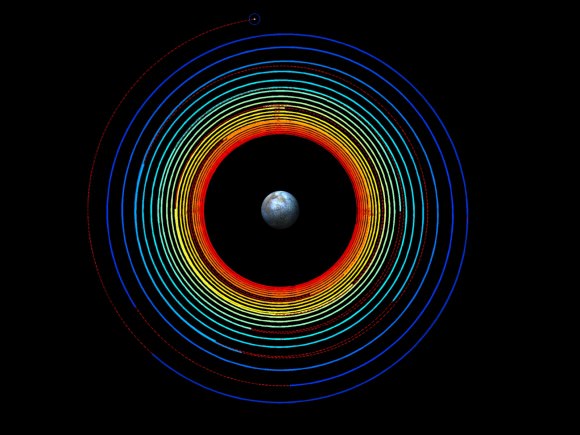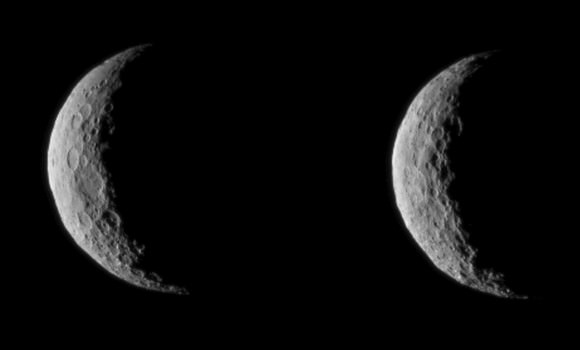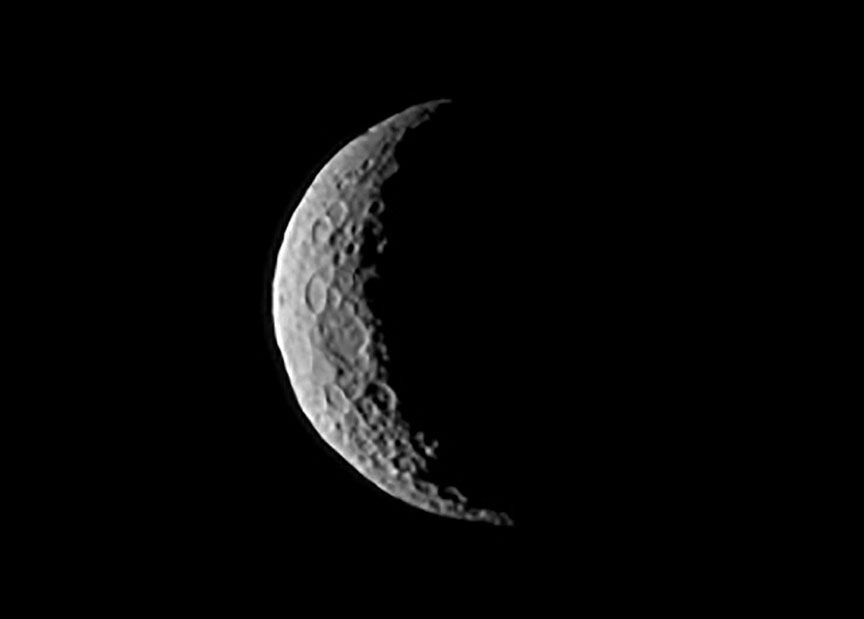Dawn’s approach and trajectory as it begins its orbital “dance” with Ceres. As you watch, note the timeline at upper right.
Dawn made it! After a 14-month tour of the asteroid Vesta and 2 1/2 years en route to Ceres, the spacecraft felt the gentle tug of Ceres gravity and slipped into orbit around the dwarf planet at 6:39 a.m. (CST) Friday morning.
“We feel exhilarated,” said lead researcher Chris Russell at the University of California, Los Angeles, after Dawn radioed back the good news.
Not only is this humankind’s first probe to orbit a dwarf planet, Dawn is the only spacecraft to fly missions to two different planetary bodies. Dawn’s initial orbit places it 38,000 miles (61,000 km) from Ceres with a view of the opposite side of Ceres from the Sun. That’s why we’ll be seeing photos of the dwarf planet as a crescent for the time being. If you watch the video, you’ll notice that Dawn won’t see Ceres’ fully sunlit hemisphere until early-mid April.

The spacecraft will spend the next month gradually spiraling down to Ceres to reach its “survey orbit” of 2,730 miles in April. From there it will train its science camera and visible and infrared mapping spectrometer to gather pictures and data. The leisurely pace of the orbit will allow Dawn to spend more than 37 hours examining Ceres’ dayside per revolution. NASA will continue to lower the spacecraft throughout the year until it reaches its minimum altitude of 235 miles.

“Since its discovery in 1801, Ceres was known as a planet, then an asteroid and later a dwarf planet,” said Marc Rayman, Dawn chief engineer and mission director at JPL. “Now, after a journey of 3.1 billion miles (4.9 billion kilometers) and 7.5 years, Dawn calls Ceres, home.”
More about Dawn’s incredible accomplishment can be found in the excellent Dawn Journal, written by Dawn chief engineer and mission director Marc Rayman.


It’s the DAWNing of the age of Ceres 🙂
http://youtu.be/oPK7ZF6jfJE
Hi Bob; thanks for update…
Let me clarify some issues…:
As I understand, Dawn was captured (gravitationally) by Ceres… It is obvious…
But, the statement : “…slipped into orbit around the dwarf planet…” may need correction… It gives an impression that, Dawn , actually, has entered the orbit… !
According to “timeline” on the video, it seems that, by the help of its ion engine, Dawn is moving to its planned (first, real) orbit…
If we assume that, shutting the ion-engine down would be the starting point of the first orbit, it will happen on the last week of April…!
Since last weeks, we were waiting for more closer images of the white spots… We expected that the “white-spot issue” wolud be solved in this week…
Nobody told us (in last three-two weeks) that we are well away from that point…
Well, as I understand it, in case they would not use the ion-engine, then Dawn would stay in a orbit around Ceres (albeit a wide orbit) – so this is meant by the “slipped into orbit” AFAIK.
Now, they’ll use the ion-engine to achieve gradually a closer orbit.
Gozlemci,
Dawn’s final orbit is an ongoing affair that will take many months, but according to NASA the spacecraft began its orbit of Ceres on March 6 as described in the article. As for the white spot I wrote either here or in my blog that Dawn was closest to Ceres in late February and had been moving away – for a few weeks – to prepare for orbit. Now we’re seeing the shadowed side and from a greater distance than in Feb., so better pictures of the white spots won’t come for at least a couple more weeks.
Aha the star trek legend of hopping between worlds proves true!
We’ve waited this long… so what’s a couple more weeks? Still, the soonest closeup images of the mysterious ‘white spots’ will be appreciated! Keep em coming!
Bob, I have read numerous news articles about Ceres recently. The prospect of those white spots turning out to be SOMETHING has captured the world’s attention and no doubt has many people’s imagination all fired up (mine included.)
It seems that all reports agree that the dawn orbiter is in orbit around ceres. So to be clear it is now in a wide orbit AROUND the spherical object? How is it then that now that it has established orbit, we have not seen any more pictures, besides the ones from the approach?
This makes no sense to me.
Even if the initial phase of orbit takes it out farther than the earlier closest approach, presumably causing some loss of detail, now no more pictures all of a sudden, until April? The dark side explanation doesn’t hold water. The orbiter would only be occulted by Ceres for hours…not weeks. So the signals from Dawn shouldn’t be blocked by Ceres for a significant amount of time as some outlets have been explaining. Also, as it was approaching it was gradually coming to face the dark side. Now that it is in orbit how do we not have half “days” views of the light side of Ceres every time dawn completes an orbit? What am I missing? Is the “photo-fudging” camp actually correct?
Hi Mike,
It’s not that we’ll see no images of Ceres, just pictures taken from a little farther away for a time and from the side of Ceres that from Dawn’s view is mostly in shadow. I’m sure NASA will share additional crescent Ceres images. To best understand why we have to wait a while for a full sunlight view again is to watch the video while keeping an eye on the date counter in the upper right corner. You’ll see Dawn spends a fair amount of time on Ceres’ farside before looping back in close in full sunlight.
Let me know if this makes things clearer.
The difference between a solar orbit and a Ceres orbit at this point is nothing more than a good push off the starting blocks in a foot race – very tenuous but its all that is needed for now.
Sorry, I’m a bit late to the party. Did anyone figure out the whole “white spot” business? I really wish people could tune in to the images and not wait for the space agencies to put them out. You know, like amateur radio. Build a receiver, download the software and have your own “listening station”.